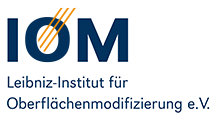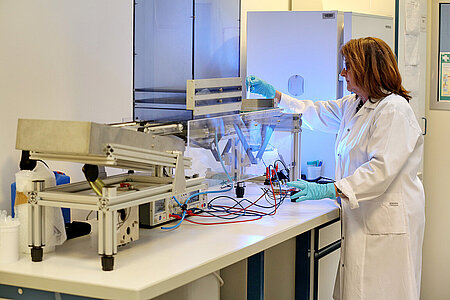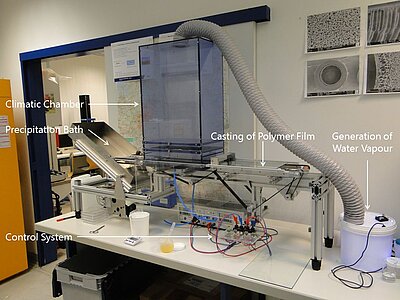The focus of this research unit is the development of porous polymer membranes with tailored membrane properties, such as e.g. pore structure and pore size, or functionalities, such as e.g. the removal of harmful substances from water. Radiation induced synthesis methods are used alongside phase inversion processes to create porous polymer structures. The latter can be used to produce hollow fiber as well as flat sheet membranes using compact and semi-automatic devices built at the IOM. Furthermore, research is conducted to develop membranes based on recycling polymers to support a sustainable usage of our given resources. The membranes obtained in this research unit are used as the basis for the work of other research units within the department, e.g. for irradiation-induced modification reactions.
Expertise
- Preparation and development of polymer membranes (micro- and ultrafiltration) with tailored properties and functionalities using semi-automatic devices
- Preparation of polymer membranes based on recycling materials
Membrane analysis
Selection
- Permeance (dead-end, cross-flow)
- Bubble point, MWCO, sieve curve analysis, Hg porosimetry
- Contact angle, surface free energy
- Zeta potential, surface charge density
- Protein adsorption (BCA test)
- Fouling (proteins, algae, waste water, surface water,…)
- Toxicity (luminous bacteria)
- Enzyme acitivity (various enzymes)
- Photocatalytic activity (static and continuous mode)
- Adsorption of micropollutants
- REM, TEM, AFM
- Tensile test, DMA
- TOC, ICP-OES, SPME-GC/MS
- IR, Raman, UV/VIS
- XPS, XRD, EDX
Highlights
Reduction of biofouling of a microfiltration membrane using amide functionalities - hydrophilization without changes in morphology
D. Breite, M. Went, A. Prager, M. Kühnert, A. Schulze
Polymers 12 (2020) 1379
https://doi.org/10.3390/polym12061379A major goal of membrane science is the improvement of the membrane performance and the reduction of fouling effects, which occur during most aqueous filtration applications. Increasing the surface hydrophilicity can improve the membrane performance (in case of aqueous media) and decelerates membrane fouling. In this study, a PES microfiltration membrane (14,600 L m−2 h−1 bar−1) was hydrophilized using a hydrophilic surface coating based on amide functionalities, converting the hydrophobic membrane surface (water contact angle, WCA: ~90°) into an extremely hydrophilic one (WCA: ~30°). The amide layer was created by first immobilizing piperazine to the membrane surface via electron beam irradiation. Subsequently, a reaction with 1,3,5-benzenetricarbonyl trichloride (TMC) was applied to generate an amide structure. The presented approach resulted in a hydrophilic membrane surface, while maintaining permeance of the membrane without pore blocking. All membranes were investigated regarding their permeance, porosity, average pore size, morphology (SEM), chemical composition (XPS), and wettability. Soxhlet extraction was carried out to demonstrate the stability of the applied coating. The improvement of the modified membranes was demonstrated using dead-end filtration of algae solutions. After three fouling cycles, about 60% of the initial permeance remain for the modified membranes, while only ~25% remain for the reference.
Estradiol removal by adsorptive coating of a microfiltration membrane
Niavarani, D. Breite, A. Prager, B. Abel, A. Schulze
Membranes 11 (2021) 99
DOI: 10.3390/membranes11020099This work demonstrates the enhancement of the adsorption properties of polyethersulfone (PES) microfiltration membranes for 17β-estradiol (E2) from water. This compound represents a highly potent endocrine-disrupting chemical (EDC). The PES membranes were modified with a hydrophilic coating functionalized by amide groups. The modification was performed by the interfacial reaction between hexamethylenediamine (HMD) or piperazine (PIP) as the amine monomer and trimesoyl chloride (TMC) or adipoyl chloride (ADC) as the acid monomer on the surface of the membrane using electron beam irradiation. The modified membranes and the untreated PES membrane were characterized by scanning electron microscopy (SEM), X-ray photoelectron spectroscopy (XPS), water permeance measurements, water contact angle measurements, and adsorption experiments. Furthermore, the effects of simultaneous changes in four modification parameters: amine monomer types (HMD or PIP), acid monomer types (TMC or ADC), irradiation dosage (150 or 200 kGy), and the addition of toluene as a swelling agent, on the E2 adsorption capacity were investigated. The results showed that the adsorption capacities of modified PES membranes toward E2 are >60%, while the unmodified PES membrane had an adsorption capacity up to 30% for E2 under similar experimental conditions, i.e., an enhancement of a factor of 2. Next to the superior adsorption properties, the modified PES membranes maintain high water permeability and no pore blockage was observed. The highlighted results pave the way to develop efficient low-cost, stable, and high-performance adsorber membranes.
Photosensitizer-loaded hydrogels for photodynamic inactivation of multirestistant bacteria in wounds
S. Glass, M. Kühnert, N. Lippmann, J. Zimmer, R. Werdehausen, B. Abel, V. Eulenburg, A. Schulze
RSC Adv. 11 (2021) 7600-7609
https://doi.org/10.1039/D0RA09786APhotodynamic treatment is a promising tool for the therapy of multidrug-resistant bacteria. In this study, we highlight photosensitizer-loaded hydrogels as an application system for infected wounds. The poly(ethylene glycol) diacrylate-based and electron beam-polymerized hydrogels were mechanically stable and transparent. They were loaded with two photoactive, porphyrin-based drugs – tetrakis(1 methylpyridinium-4-yl)porphyrin p-toluenesulfonate (TMPyP) and tetrahydroporphyrin – p toluenesulfonate (THPTS). The hydrogels released a sufficient amount of the photosensitizers (up to 300 μmol l−1), relevant for efficiency. The antimicrobial effectivity of loaded hydrogels was investigated in a tissue-like system as well as in a liquid system against a multiresistant Escherichia coli. In both systems, light induced eradication was possible. In contrast, hydrogels alone showed only minor antimicrobial activity. Furthermore, the loaded hydrogels were successfully tested against seven multidrug-resistant bacterial strains, namely Enterococcus faecium, Staphylococcus aureus, Klebsiella pneumonia, Acinetobacter baumannii, Pseudomonas aeruginosa, Escherichia coli and Achromobacter xylosoxidans. The eradication of these pathogens, except A. xylosoxidans, was successfully demonstrated. In general, TMPyP-loaded hydrogels were more effective than THPTS-loaded ones. Nevertheless, both photosensitizers displayed effectivity against all investigated bacteria strains. Taken together, our data demonstrate that photosensitizer-loaded hydrogels are a promising new tool to improve the treatment of wounds infected with problematic bacterial pathogens.
Design of modified polymer membranes using machine learning
S. Glass, M. Schmidt, P. Merten, A. A. Latif, K. Fischer, A. Schulze, P. Friederich, V. Filiz
ACS Appl. Mater. Interfaces 16 (2024) 20990-21000
10.1021/acsami.3c18805Surface modification is an attractive strategy to adjust the properties of polymer membranes. Unfortunately, predictive structure–processing–property relationships between the modification strategies and membrane performance are often unknown. One possibility to tackle this challenge is the application of data-driven methods such as machine learning. In this study, we applied machine learning methods to data sets containing the performance parameters of modified membranes. The resulting machine learning models were used to predict performance parameters, such as the pure water permeability and the zeta potential of membranes modified with new substances. The predictions had low prediction errors, which allowed us to generalize them to similar membrane modifications and processing conditions. Additionally, machine learning methods were able to identify the impact of substance properties and process parameters on the resulting membrane properties. Our results demonstrate that small data sets, as they are common in materials science, can be used as training data for predictive machine learning models. Therefore, machine learning shows great potential as a tool to expedite the development of high-performance membranes while reducing the time and costs associated with the development process at the same time.
Synthesis of composite imprinted polymer membranes for the selective removal of 17β-estradiol from water

Z. Niavarani, D. Breite, A. Prager, I. Thomas, M. Kuehnert, B. Abel, R. Gläser, A. Schulze
Mater. Chem. Front. 7 (2023) 4460-4472
https://doi.org/10.1039/D3QM00345KComposite microfiltration polyethersulfone membranes incorporating molecularly imprinted particles (MIPs) were developed for efficient and selective adsorption of 17β-estradiol from water. MIP particles were synthesized via precipitation polymerization, with 17β-estradiol as the template molecule. The composite membranes were prepared by embedding the MIPs into the membrane matrices using phase inversion process. Electron beam irradiation was used to covalently immobilize the MIP particles within the membrane scaffold. The synthesized membranes were characterized using scanning electron microscopy (SEM), X-ray photoelectron spectroscopy (XPS), water contact angle analysis, permeation tests and mercury porosimetry. The adsorption loading, selectivity, reusability, and adsorption isotherms were studied through batch and dynamic adsorption experiments. The results indicated significant adsorption loading of 17β-estradiol (12.9 ± 1 mg g−1) and selectivity factors as high as 6.2 and 12.5 for 17β-estradiol in the presence of model micropollutants (such as bisphenol A and citalopram), respectively. Moreover, the composite membranes were regenerated and reused without any significant loss in adsorption loading for 10 subsequent cycles. The maximum adsorption capacity of 17β-estradiol on the composite membrane, calculated by fitting experimental data with the Langmuir equation, was 21.9 mg g−1, which is more than a 200-fold increase in the adsorption loading compared to commercial nanofiltration. These composite microfiltration membranes exhibit a high adsorption loading accompanied by lower pressure requirements for filtration, high water permeation, and extended reusability, rendering them a viable and sustainable option for water purification processes.


